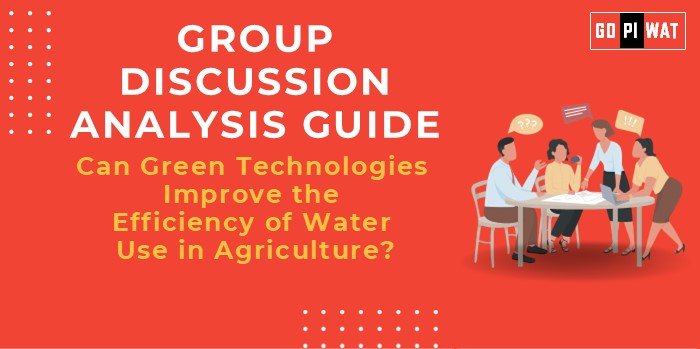📋 Group Discussion Analysis Guide
Can Green Technologies Improve the Efficiency of Water Use in Agriculture?
🌍 Introduction to the Topic
- 🌐 Opening Context: With agriculture accounting for approximately 70% of global freshwater withdrawals, water efficiency is critical for sustainable food production.
- 📖 Topic Background: Green technologies, encompassing precision irrigation, smart sensors, and water recycling, are transforming water use in agriculture. These technologies aim to optimize resource use while addressing the global water crisis.
📊 Quick Facts and Key Statistics
- 🌍 Global Water Withdrawals for Agriculture: 70% – highlights the sector’s dependence on water resources.
- 🚰 Water Wastage in Conventional Irrigation: ~60% due to inefficiencies in delivery systems.
- 🌱 Adoption of Drip Irrigation: Improves water efficiency by up to 50% compared to traditional methods.
- 🇮🇳 India’s Irrigation Efficiency Gap: Stands at 38%, indicating significant room for improvement.
🌍 Stakeholders and Their Roles
- 👩🌾 Farmers: Adopting and implementing green technologies in fields.
- 🏛️ Governments: Subsidizing technology and creating awareness programs.
- 🏢 Private Sector: Innovating and deploying scalable solutions like AI-driven irrigation systems.
- 🌐 NGOs and International Bodies: Supporting smallholder farmers through education and funding.
🏆 Achievements and Challenges
Achievements:
- 🌟 Precision Agriculture: Farmers in Israel reduced water use by 25% while increasing yields.
- 🚜 Drip Irrigation in India: States like Maharashtra saved 30-50% water in sugarcane farming.
- 💧 Wastewater Recycling in Urban Agriculture: Implemented in Singapore with over 40% reuse efficiency.
Challenges:
- 💸 High Initial Costs: Advanced systems can be expensive to install and maintain.
- 📖 Lack of Technical Knowledge: Many smallholder farmers struggle with adopting new technologies.
- 📜 Limited Policy Frameworks: Few incentives exist for green tech adoption in some regions.
📖 Global Comparisons:
- 🇮🇱 Israel: Demonstrates scalable models of water-efficient farming through precision irrigation.
- 🇳🇱 Netherlands: Integrates advanced water management systems in agriculture.
📖 Case Study:
- 🇮🇳 Punjab, India: Adopting micro-irrigation techniques saved water while sustaining wheat yields.
💬 Structured Arguments for Discussion
- ✅ Supporting Stance: “Green technologies have significantly reduced water consumption in agriculture while maintaining productivity.”
- ❌ Opposing Stance: “High costs and lack of access hinder the widespread adoption of these technologies in developing regions.”
- ⚖️ Balanced Perspective: “While impactful, the success of green technologies depends on affordability, accessibility, and supportive policies.”
🗣️ Effective Discussion Approaches
Opening Approaches:
- 📊 “Did you know that agriculture uses 70% of the world’s freshwater, but half of it is wasted due to inefficiencies?”
- 🌐 “Israel, with scarce water resources, has revolutionized farming using green technologies.”
Counter-Argument Handling:
- 💡 Acknowledge cost and technical barriers while proposing government incentives or community-driven solutions.
📊 Strategic Analysis of Strengths and Weaknesses
- 💪 Strengths: Reduces water use, improves crop yield, promotes sustainability.
- ❌ Weaknesses: High upfront costs, technology dependence, limited scalability.
- 🌟 Opportunities: Integration of AI, public-private partnerships, government subsidies.
- ⚠️ Threats: Water scarcity, climate change, uneven technology adoption.
🎓 Connecting with B-School Applications
- 🌐 Real-World Applications: Green technologies link to operational efficiency and sustainable business practices.
- 🎯 Sample Interview Questions:
- “How can green technologies balance economic and environmental goals in agriculture?”
- “Discuss a policy you would recommend to encourage water-efficient farming.”
- 📘 Insights for B-School Students:
- Explore project themes in agritech innovation.
- Develop business strategies for sustainable farming or policy advocacy.


